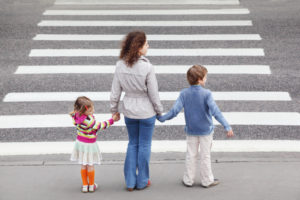Road safety has to be taught; it does not come automatically. And for any early-years setting, road safety considerations have to be a priority.
Young children often have difficulty judging speed and distance. They are easily distracted and prone to act on impulse. When a ball goes into the road, their first instinct will be to follow it, rather than think about the fact that a vehicle might be approaching. Their height means that hazards are often out of their sight (assuming they would know what a hazard comprises) whilst their eyesight and hearing are still developing.
Children find it very difficult to understand danger and death. But as adults, we know that a road is a very dangerous place to be, as is anywhere where vehicles are moving.
Whilst at a childcare setting, children should not be allowed to play in areas where people park their cars. Outside play areas should be as far away as possible from car parks and adjacent roads. Any play area should be clearly fenced off with access via a gate that is kept permanently fastened. Children should be supervised at all times to make sure they do not attempt to climb over the fence or they can be lifted over the fence.
If children are being taken out of the setting for any reason, they must of course be carefully monitored and kept well away from the sides of the roads. Wearing reflective clothing will ensure that road users can clearly see the children. Adults should hold children’s hands or use reins on very young children.
The basics
Within the setting, time should be devoted to teaching children basic road safety. Always check first with the parents and guardians to make sure that the children have not been hurt in, bereaved or witnessed a serious road crash. Even very young children may have experienced a road crash when strapped in a parent’s car. They may not fully understand what happened, but could be more easily frightened and distressed. If they have, the subject can still be dealt with sensitively to avoid distressing them any further. Very young children in this situation may need to be excluded from road safety sessions.
From the age of two, every child can begin to understand the basic elements of road safety. Nannies should focus on the key features of road safety for this age group:
- Paths and pavements are for people, roads are for traffic.
- When riding in cars, children should not play with door handles or try to get out. They must not undo their safety belt, or distract the driver.
- They should stop when they are told to do so, and never cross a road with permission.
- Children should hold an adult’s hand, and not let go, whenever they are near a road.
- Do not play on roads, or run into the road.
- Wear bright clothes so that drivers can see them.
Above all, the message to stress is that traffic is dangerous.

It can help to organise a carefully supervised session where the children are taken into a car park to look at a stationary car. The children can then compare the touch of the car with their own tummy. Which is soft and which is hard? This will help them understand that a car is a hard object and can hurt. Touching the wheels emphasises its size and firmness. Comparing this with the way the wheels on toy cars will move very fast stresses the danger posed by car wheels.
Teaching road safety can link into other subjects such as teaching about colours, numbers, sizes. It can also highlight other potential problems such as colour blindness. Identifying the difference between red and green on a traffic light is crucial for road safety – but red/green colour blindness is not unusual.
Be resourceful
There are lots of resources available to teach pre-schoolers about road safety. Many can be downloaded from the internet such as:
www.roadsafetyweek.org/schools-colleges/2-uncategorises/69-road-safety-lesson-plans#twofive
These resources incorporate games, posters, books and playmats as well as ideas for craft work. All the activities are easy to undertake in an early-years setting such as holding a toy car race to explore simple concepts like which is fastest? Which will go furthest before it stops? Which car is far away? Drawing round adult and child hands, then clipping them together helps stress the need to hold hands when out and about.
The importance of role-play must not be underestimated when teaching road safety. Children love passing on information that they have learned, especially when it comes to teaching their teddies and dolls. Encourage them to teach teddies and dolls about road safety. Place a skipping rope on the floor to mark the edge of the kerb on a pavement. Children can take their teddies or dolls for a little walk along the ‘kerb’ and instruct them why they must stop at the kerb. Adding in a few toy cars along the ‘roadway’ will help reinforce the message that these can be hazards, that moving vehicles might be hidden behind them. By acting out different scenarios, children can begin to understand the dangers posed by roads and vehicles. As they want to keep their teddies or dolls safe, they will absorb the messages much more easily.
Children should also be taught to listen and distinguish the different sounds related to road safety. The sound of a police car or fire engine rushing along the road is very distinctive and it will be moving very fast. Recording these sounds and playing them back for children will help them identify each one.
Teaching road safety to even the youngest child will save lives.


